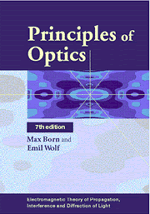Book contents
- Frontmatter
- Preface to corrected reprint of the seventh edition
- Preface to the first edition
- Preface to the second edition
- Preface to the third edition
- Preface to the fourth edition
- Preface to the fifth edition
- Preface to the sixth edition
- Preface to the seventh edition
- Contents
- Historical introduction
- I Basic properties of the electromagnetic field
- II Electromagnetic potentials and polarization
- III Foundations of geometrical optics
- IV Geometrical theory of optical imaging
- V Geometrical theory of aberrations
- VI Image-forming instruments
- VII Elements of the theory of interference and interferometers
- VIII Elements of the theory of diffraction
- IX The diffraction theory of aberrations
- X Interference and diffraction with partially coherent light
- XI Rigorous diffraction theory
- XII Diffraction of light by ultrasonic waves
- XIII Scattering from inhomogeneous media
- XIV Optics of metals
- XV Optics of crystals
- Appendices
- Author index
- Subject index
VII - Elements of the theory of interference and interferometers
- Frontmatter
- Preface to corrected reprint of the seventh edition
- Preface to the first edition
- Preface to the second edition
- Preface to the third edition
- Preface to the fourth edition
- Preface to the fifth edition
- Preface to the sixth edition
- Preface to the seventh edition
- Contents
- Historical introduction
- I Basic properties of the electromagnetic field
- II Electromagnetic potentials and polarization
- III Foundations of geometrical optics
- IV Geometrical theory of optical imaging
- V Geometrical theory of aberrations
- VI Image-forming instruments
- VII Elements of the theory of interference and interferometers
- VIII Elements of the theory of diffraction
- IX The diffraction theory of aberrations
- X Interference and diffraction with partially coherent light
- XI Rigorous diffraction theory
- XII Diffraction of light by ultrasonic waves
- XIII Scattering from inhomogeneous media
- XIV Optics of metals
- XV Optics of crystals
- Appendices
- Author index
- Subject index
Summary
Introduction
IN Chapter III a geometrical model of the propagation of light was derived from the basic equations of electromagnetic theory, and it was shown that, with certain approximations, variations of intensity in a beam of light can be described in terms of changes in the cross-sectional area of a tube of rays. When two or more light beams are superposed, the distribution of intensity can no longer in general be described in such a simple manner. Thus if light from a source is divided by suitable apparatus into two beams which are then superposed, the intensity in the region of superposition is found to vary from point to point between maxima which exceed the sum of the intensities in the beams, and minima which may be zero. This phenomenon is called interference. We shall see shortly that the superposition of beams of strictly monochromatic light always gives rise to interference. However, light produced by a real physical source is never strictly monochromatic but, as we learn from atomistic theory, the amplitude and phase undergo irregular fluctuations much too rapid for the eye or an ordinary physical detector to follow. If the two beams originate in the same source, the fluctuations in the two beams are in general correlated, and the beams are said to be completely or partially coherent depending on whether the correlation is complete or partial. In beams from different sources, the fluctuations are completely uncorre-lated, and the beams are said to be mutually incoherent. When such beams from different sources are superposed, no interference is observed under ordinary experimental conditions, the total intensity being everywhere the sum of the intensities of the individual beams.
- Type
- Chapter
- Information
- Principles of OpticsElectromagnetic Theory of Propagation, Interference and Diffraction of Light, pp. 286 - 411Publisher: Cambridge University PressPrint publication year: 1999
- 8
- Cited by



